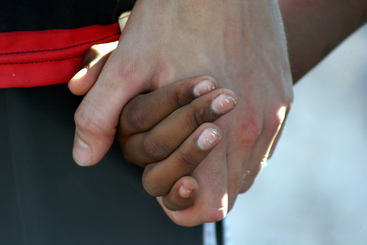The Transformative Power of Vulnerability
February 04, 2016 • By Pamela Sue Anderson
Last month, a 29-year old man shot a woman in a movie theatre in a suburb of Seattle when his concealed gun accidentally went off. He was carrying the weapon, he said, because of his fear of mass shootings. This strange logic generates an ending that is precisely the opposite of what was desired: rather than offering protection, his gun made the world less safe.
The man was striving for invulnerability. Like many US citizens today, he thought his vulnerability could be overcome with possession of a gun. But the data is very clear: the very presence of more and more guns continually increases the violence. Striving for invulnerability puts us at risk. And it misses the opportunity that vulnerability can offer.
In our contemporary global world we tend to think of vulnerability as an openness to violence and death. I propose that vulnerability can also be a capability for openness to mutual affection. In her very first poem, written at the age of 14, the American poetess Sylvia Plath recognized that vulnerability is inherent in life: “I thought that I could not be hurt …Then suddenly my world turned gray, and darkness wiped aside my joy. A dull and aching void was left, where careless hands had reached out to destroy my silver web of happiness.” Vulnerability colours a deeply shared dimension of our lives together as human beings. Failing to recognize and accept this vulnerability can, ironically, leave us open to even greater hurt and loss. In my current research, I have hypothesized that vulnerability serves as a provocation for enhancing life by creating a space for transformation. It’s an opening for change, whether through loss or joy. It forces us, quite simply, to stop and think.
The idea that vulnerability can be seen as a positive is controversial, even in religious settings where one might expect a consistent embrace of the vulnerable. Yet for generations, Christian theologians have treated corporeal vulnerability as something both negatively associated with women as “fleshy bodies.” Just think of some denominations of the Christian Church, in which a woman wouldn’t be allowed to touch the host (as the body of Christ) because of her “unclean” flesh. We can also think of practices in Judaism like niddah, the actual separation of a woman from men whenever blood is coming from her womb (whether menstruation, childbirth or sexually transmitted disease). Women must then ritually immerse themselves in water (mikveh) to purify their flesh/body. In this way, traditional religious rituals have reduced women to—and excluded them because of—the wounds of their bodies. The word “vulnerable” derives from the Latin vulnerare, “to wound” and from vulnus, “a wound.” To generalize: religious men have thought women are vulnerable like an open wound; hence, their bodies risk defiling and spreading infection, if not becoming dangerously seductive. So when perceived as vulnerable—like a wound losing blood—women’s fleshy bodies aren’t allowed in certain places or parts of worship.
In contrast, my focus on vulnerability is on transformative experiences like critical illness, personal bereavement, or the birth of a child, when people have been able to discover not only their openness to possible harm or pain, but also an openness to change and growth. For instance, bereavement is rightly followed by a process of grief, but in becoming undone by the loss of a loved one, we are inevitably forced to change. Life can never be the same without that loved one, but the wound of loss makes us recognize the reality of one’s love in that vulnerability. This recognition gives us the strength to move forward. The hope would be, after recognizing one’s vulnerability, that one could live more openly and fully for oneself and others who are equally open.
Recent ritual practices of restorative justice have attempted to initiate a process that, if properly designed, would facilitate mutual openness between the one who has been seriously hurt and the one who has caused the serious pain. The hope is that this shared vulnerability might bring about ethical reparation. However, this reciprocal process of restoring justice assumes a relational striving to become what we are most “deeply.” Again, Plath expresses this: “How frail the human heart must be – a throbbing pulse, a trembling thing – a fragile, shining instrument of crystal, which can either weep, or sing.” Perhaps if, and when, corporeal vulnerability is recognised as a capability for openness to other people and to novel possibilities – like becoming transformed through a process like restorative justice - then we can discover it as (Plath’s) “crystal” through which we envision a joyful transformation of our lives.
The openness of corporeal vulnerability, which is like “a throbbing pulse” and “a trembling thing,” is deeply relational; and for this reason, it can involve a becoming in the sense of enhancing life relationally; here my concept would be "mutual affection." Thus, I recognise my ongoing challenge is to confront the restrictive – strictly negative - uses of "vulnerability." This concept tends to be understood in contemporary, social and political worlds as negative; it is “the hurt,” which Plath’s describes, but without the capacity to “sing.” Corporeal vulnerability has been referred to by Christian theologians as “the flesh” of the body which needs to be discarded and replaced with “the spiritual” body. As a result, those associated with the flesh—like fleshy female bodies, or the failing flesh of the injured, ill, and dying—are treated as less capable than those who are thought to have achieved invulnerability. My Enhancing Life project aims to challenge invulnerability as impossible or self-defeating and instead claim that vulnerability can become a desirable condition that ultimately enhances life.
Read a Q&A with Pamela Sue Anderson about her research here.
Photo courtesy of Ben via Flickr (Creative Commons license).